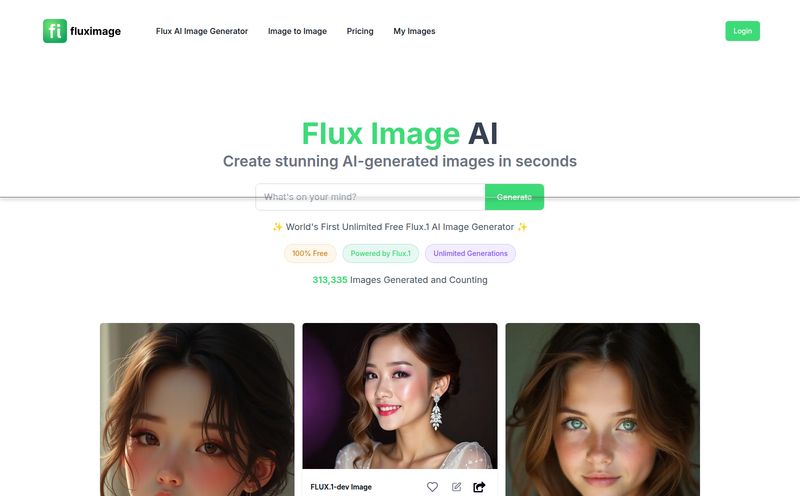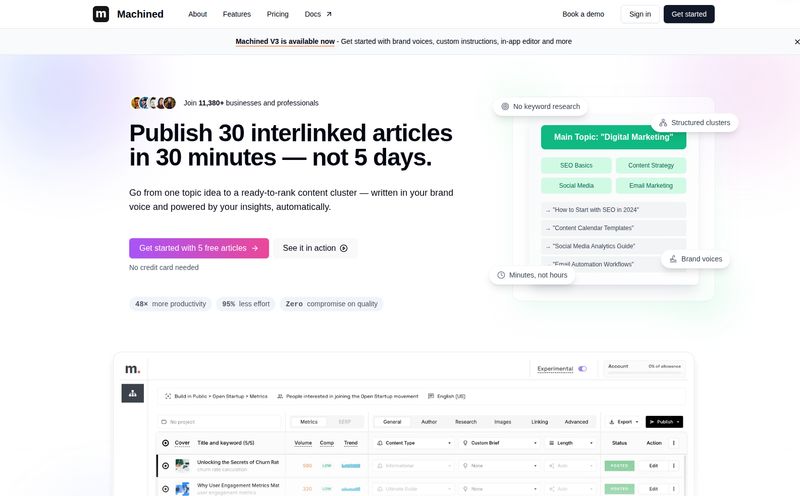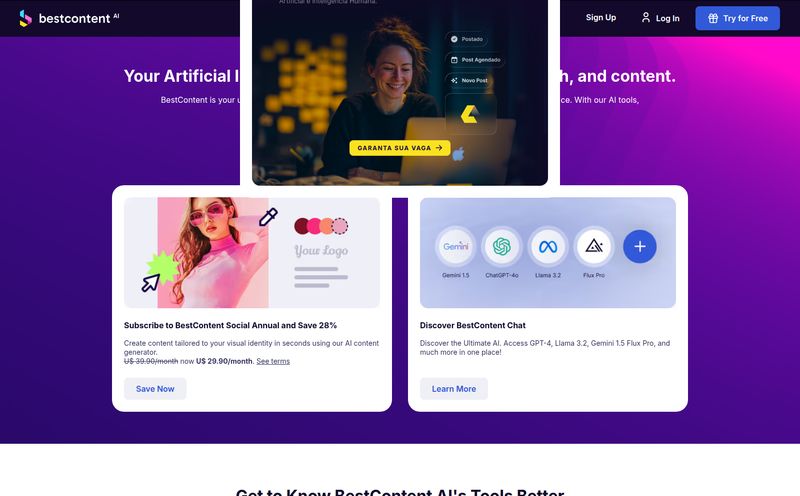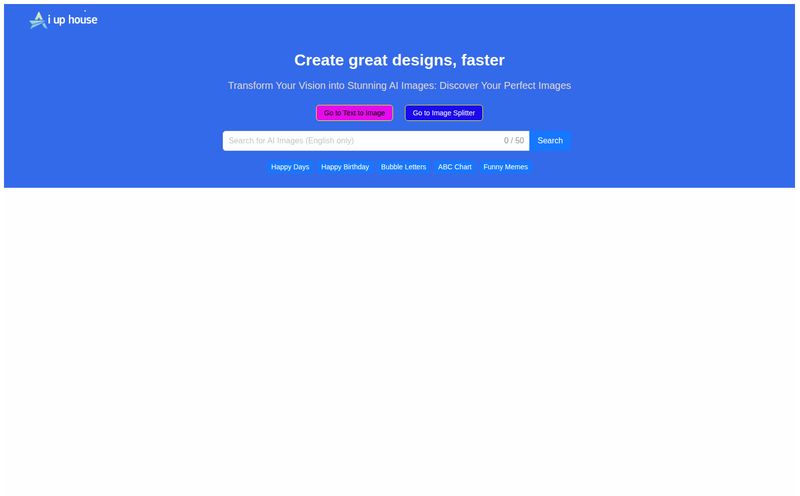Alright, let’s have a real chat. How many tabs do you have open right now? If you’re anything like me, a content marketer who’s been in the trenches for years, you’ve probably got one for your keyword research, one for a stock photo site (that you’ll probably close in frustration), another for a clunky online background remover, and maybe even a fourth for Canva. It’s a digital juggling act, and frankly, I'm tired of it.
For years, my workflow for creating a single blog post visual felt like assembling a piece of IKEA furniture with half the instructions missing. The time suck is real. So when I stumble across a tool that claims to put everything under one roof, my professional skepticism immediately kicks in. But so does my hope. This week, that tool was Crayon AI.
Is it another flash-in-the-pan AI gimmick, or is it the digital multitool we’ve all been waiting for? I spent some time poking around, and I have some thoughts. Let's get into it.
What Exactly is Crayon AI? (And Why Should You Care?)
So what’s the big idea here? Crayon AI isn’t just another text-to-image generator flooding the market. Think of it more like a Swiss Army knife for your JPEGs and PNGs. It’s a suite of tools, all powered by AI, designed to handle the most common (and often, most annoying) image tasks that content creators face daily. We're talking generating images from scratch, quick edits, removing backgrounds, and even restoring old, grainy photos.
The main appeal, at least for me, is the consolidation. Instead of paying for three different subscriptions and remembering five different logins, the idea is to have one streamlined platform. In a world where every company wants you on their monthly plan, a tool that simplifies your stack is already winning points in my book.
A Closer Look at the Crayon AI Toolkit
A tool is only as good as its features, right? So I took a tour of the Crayon AI dashboard to see what it's really working with. It's more than just a one-trick pony.
The AI Image Generator: From Text to Visuals
This is the feature that gets all the headlines these days. You type in a prompt, and a machine learning model spits out an image. Crayon AI’s generator is pretty straightforward. I've seen my fair share of these, from Midjourney’s beautiful but complex Discord-based system to DALL-E. Crayon AI feels much more approachable. It’s a simple text box that invites you to be creative. The quality? Like most AI generators, it can be a bit of a lottery. Sometimes you get gold, sometimes you get a guy with three arms. But for generating unique blog headers or social media graphics without trawling through stock photo libraries, it's a solid starting point.
The Photo Editor and Background Remover
Now this… this is where my interest really piqued. The background remover is the unsung hero of digital marketing. I can't tell you how many hours I've lost meticulously tracing product shots with the Photoshop Pen Tool. Crayon AI's one-click background removal is a lifesaver. It’s not always pixel-perfect on super complex images with hair or fur, but for 90% of the daily tasks a marketer faces? It's more than good enough. The included photo editor is also handy for quick crops, brightness adjustments, or adding text—no need to open a separate program.
Restoring Old Photos and Upscaling Images
This is a feature that has both professional and personal appeal. Got an old, faded photo from a company event back in the 90s? The Photo Restoration tool can clean it up, sharpen the details, and bring it back to life. It’s impressive stuff. Similarly, the Upscaler is great when a client sends you a logo that’s the size of a postage stamp and expects you to put it on a billboard. We’ve all been there. This tool can increase the resolution without turning it into a pixelated mess. A genuinely useful function.
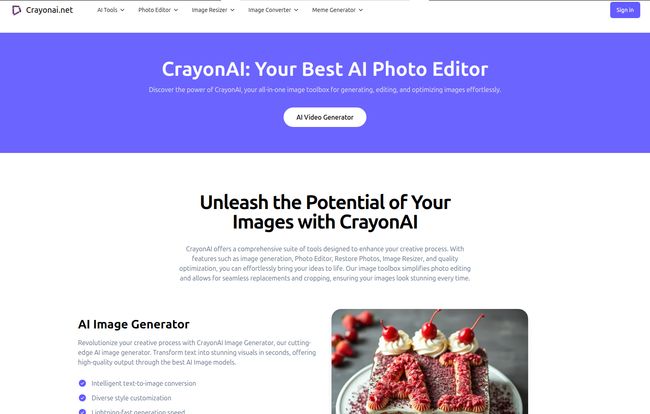
Visit CrayonAI
Let's Not Forget the Meme Generators
I have to admit, seeing a “Meme Generator” and even a “Slang Meme Generator” made me chuckle. But then I stopped. Memes are a legitimate part of brand communication now. Being able to quickly jump on a trend with a branded meme can be huge for engagement. Having this tool built right in shows that the Crayon AI team actually understands how content is made on the internet in 2024. It’s a small touch, but a smart one. It shows they're not just focused on stuffy corporate use-cases.
The User Experience: How Does It Feel to Use?
The interface is clean. It’s simple. It’s not intimidating. You land on the page, and you see big, clear buttons for each tool. There’s no ambiguity. This isn't a tool built for seasoned graphic designers who know what “dithering” and “Bezier curves” mean. This is built for the rest of us: the marketers, the small business owners, the students who just need to get a job done quickly and efficiently. It’s responsive, so it works fine on my laptop and my tablet, which is a nice touch for those moments of inspiration on the go. There's no steep learning curve, which is probably it's biggest strength.
The All-Important Question: Crayon AI Pricing
Okay, let's talk money. We all love a powerful tool, but the price has to make sense. Crayon AI uses a credit-based system, which is pretty common for AI services. Here's the breakdown as of my review:
| Plan | Price (One-Time) | Credits | Key Features |
|---|---|---|---|
| Basic Plan | $10 | 300 credits/month | Normal generation speed, limited downloads |
| Pro Plan | $20 | 800 credits/month | Fast generation speed, unlimited downloads |
The pricing is a one-time payment for 30-day access, which is an interesting model. No recurring subscription surprises. For $10 or $20, you get a significant number of credits to play with. Each action, like generating an image or removing a background, costs credits. For someone who needs a burst of creative work for a specific project, this is perfect. If you’re a heavy, daily user, you might burn through the credits, but for the average blogger or social media manager, the Pro plan's 800 credits should be plenty for a month. You can check their latest offers on the Crayon AI pricing page.
The Good, The Bad, and The AI
No tool is perfect. Let's be real. After playing around with Crayon AI, here's my honest take on its highs and lows.
On the plus side, its versatility is a huge win. The convenience of having an image generator, editor, background remover, and upscaler in one spot is just fantastic. The user-friendly interface means anyone can jump in and start creating without watching hours of tutorials. I really appreciate that.
However, there are a couple of things to keep in mind. The credit system means your usage is finite. You can't just generate images all day long on the free tier—you’ll need a paid plan for any serious work. Also, the quality of AI-generated content is, by nature, variable. You will have some creations that look a little... weird. That's not a Crayon AI problem, its a general AI problem right now. You have to be willing to iterate and refine your prompts. It’s a creative partner, not a magic button that reads your mind.
So, Who is Crayon AI Really For?
I’ve been thinking about this. A senior graphic designer at a major agency probably won't be ditching their Adobe Creative Cloud subscription for Crayon AI. And that's okay. That’s not who this is for.
This tool is for the rest of us. It's for:
- Bloggers and Content Creators who need unique featured images without breaking the bank on stock photos.
- Social Media Managers who need to pump out high-quality, engaging content and memes on a tight schedule.
- Small Business Owners who wear all the hats, including marketing, and don't have time to become a Photoshop expert.
- Students and Educators who need visuals for presentations and projects without a huge budget.
If you value speed, convenience, and “good enough” over pixel-perfect, painstaking control, then Crayon AI is going to feel like a breath of fresh air.
Frequently Asked Questions about Crayon AI
Is Crayon AI easy for beginners to use?
Absolutely. In my opinion, that's one of its biggest selling points. The interface is incredibly intuitive. If you can write an email, you can use Crayon AI. The tools are clearly labeled and do exactly what you'd expect.
How do the credits work?
Think of credits as tokens. Every time you perform an action—like generating an image, removing a background, or restoring a photo—you spend a certain number of credits. The paid plans give you a monthly allowance of these credits to use across all the tools.
Can I use the images I create for commercial purposes?
Generally, with AI image generation tools, once you create an image on a paid plan, you have broad rights to use it, including for commercial projects like your blog or social media. However, I always recommend checking the platform's most current Terms & Conditions, as these policies can evolve.
Is the background removal tool accurate?
From my tests, it's very accurate for most common use cases, like product shots or portraits with clear outlines. For extremely detailed images with things like wispy hair or complex patterns, it might struggle slightly, but it's far better than doing it by hand for quick jobs.
Is the one-time payment a subscription?
No, and this is a key differentiator. The current pricing model is a one-time payment that grants you access and credits for one month. It does not automatically renew, which is great for avoiding unwanted subscription fees.
My Final Verdict
So, is Crayon AI going to replace my entire creative workflow? No. But is it going to replace about five of the tabs I usually have open? Yes, without a doubt. It’s a powerful, convenient, and surprisingly fun little toolbox.
It successfully bridges the gap between overly simplistic, free tools and overly complex, expensive professional software. For the massive group of creators and marketers in that middle ground, Crayon AI offers incredible value. It streamlines the tedious bits of content creation, giving you back time to focus on what really matters: the ideas. And for $20, that’s a pretty great deal.
Reference and Sources
- Crayon AI Official Website: https://crayonai.net
- Crayon AI Pricing Details: https://crayonai.net/pricing
